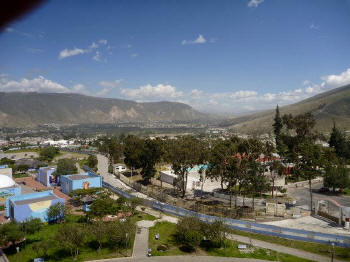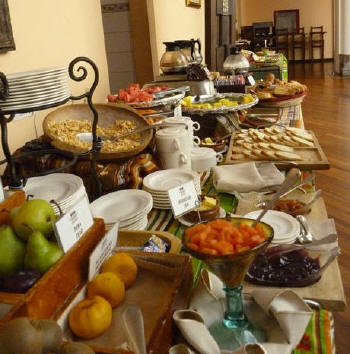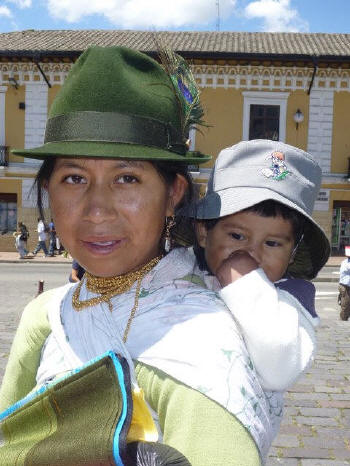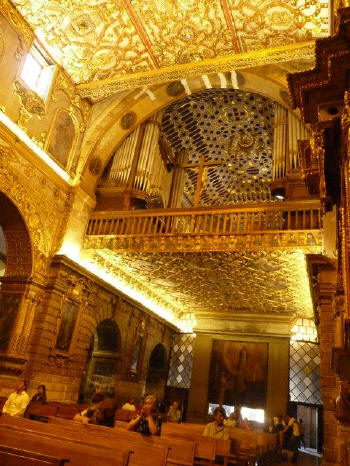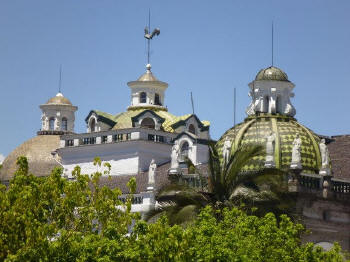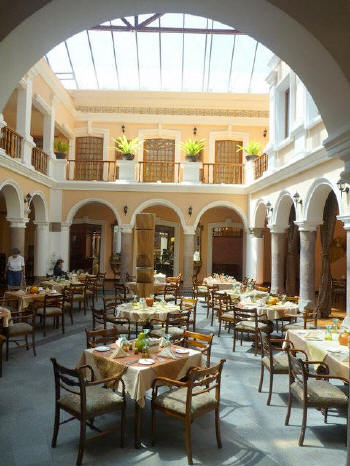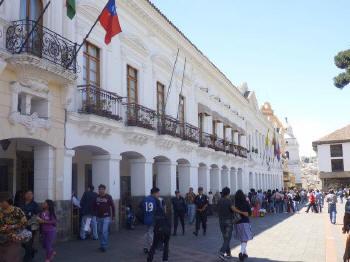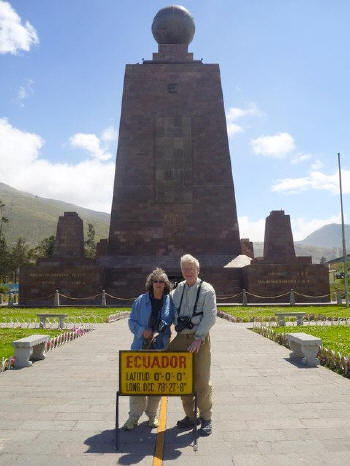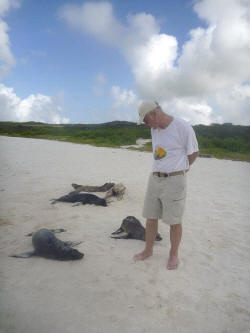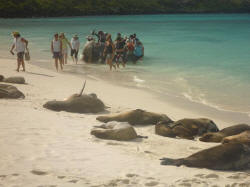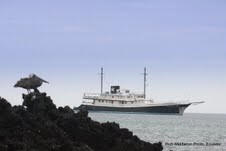Arriving Quito, Ecuador
Photographs and text © Richard and Pat Middleton. All Rights Reserved.WATERWAY CRUISE REPORT
For many who cruise the Galapagos Islands, a day in Quito will be the extent of their visit to mainland Ecuador. A few lucky cruisers will extend their stay to include several days in the Amazon jungle, or touring the Andean highlands. This is a report on our first day, our first impressions of 'surprising Quito.'
Our first full day in Quito, brought us a fistful of memorable moments. First of all, sunshine and blue skies (which accompanied us for the entire trip!); then a breakfast of delectable Ecuadorian coffee, French pastries, meats, eggs, and fruit which we enjoyed in our Hotel Mercure restaurant while people-watching along Quito's main tourist street.
The 5-star Hotel Mercure in down town Quito offered the VERY comfortable accommodations, a small casino, and helpful staff. We were very happy to return here after our various excursions.
Most English-speaking visitors arrange to have a driver and a guide upon landing at the Quito airport. It certainly eased our entry anxiety when arriving at a Spanish speaking destination nearly 9,000 feet higher than where we began our flight in Wisconsin!
We found our relationship with Quasar Expeditions to be invaluable. The Quito-based cruise company also acts as a land agent and offers expert tour planning on the mainland. We found both our driver and guide, Giovanna, to be indispensable. Driving your own rental vehicle is really not an option in the city.
Interested in experiencing a bird hike? An expedition to the rim of a volcano? Want to spend extra time diving? Your travel agent should be able to recommend guides and destinations to your specs for anywhere from a few hours to a few weeks.
The driver and guide will become your best friends in Ecuador, meeting you upon arrival at the Quito airport, easing you through customs, lost luggage, the most crowded and convoluted traffic situation imaginable, hotel registrations, and more. Giovanna provided us with near constant historical and cultural background...all of it quite foreign to us. As in the Galapagos Islands, the guides are professionally trained. She attended high school in the U.S. as an exchange student and then finished an advanced degree in tourism management. She has been guiding visitors for nearly 20 years.
Our first day, we snatched enough time for an early walk to see the marketplace just a few blocks from the hotel. Our first glimpse of the long braids, felt hats, white hats, and varied native costumes of the indigenous population. There would be even larger markets, Giovanna told us, but we could not help making
our first purchases of the soft, hand knitted alpaca sweaters, hats, embroidered shirts, and paintings of the highland life.
Giovanna met us at 9 a.m. and today we would walk the historic district of Quito. Quito has been designated a World Heritage Site, and we were amazed by the colonial collection of centuries old government buildings, cathedrals, and haciendas-turned-boutique shops planted in the midst of this Inca empire.
Various orders of the Catholic church constructed cathedrals in the 16th century to rival any in Europe. The same Jesuits who settled in Louisiana, operated "hacienda's" or plantations to fund their order (and the gold-plated interior of a huge cathedral) working among the indigenous people of the Andes.
Our walking tour would also be our first real test of whether we would deal with altitude sickness in this 9,300' high city.
"The secret," Giovanna assured us, "was not to run up the cathedral stairs!"We could suit our walking speed to whatever felt best to us. I never had another moment's concern about the altitude, though the stairs helped me appreciate that I really was visiting a city at altitude!
The tile roofs of some colonial buildings were reminiscent of the geometrical designs so prominent in the architecture of southern Spain. I was surprised again and again by the sense that we were visiting a grand city in Europe. Who would think that aspects of Moorish design would be quite common in Ecuador??!!
The restaurant shown to the right was once part of a colonial hacienda. Note the arches... again reminiscent of the Moorish design.
During our walk, Giovanna regaled us with stories of Francisco Pizzaro and the Spanish conquest of the indigenous Incas in 1534, and the eventual revolt of the native born Spanish against Colonial Spain in 1822. Ecuador becomes part of independent "Gran Colombia" which Simon Bolivar of Venezuela tries to model after the Republic of the United States.
But our day was not yet over. We had the opportunity to traverse this long valley city in order to visit "La Mitad del Mundo" which introduced the whole era of European/French study of the Equator (thus the country name of Ecuador), which crosses directly through the hills of Quito. Scientists in the 18th century were thrilled to find that in Ecuador, the Equator passed through volcanic mountain peaks, Amazonian jungle and ocean coastline. This provided a bonanza in wildlife, and indigenous people on which to build their studies and their reputations.
The area in the north of the province has been the object of a number of studies attempting to measure meridian arc in order to determine the exact figure of the Earth, with the first result being obtained in 1743 by Geodesic Mission of the French Academy of Sciences, led by Louis Godin, Pierre Bouguer and Charles Marie de La Condamine.
An excellent ethnological museum inside the monument introduced us to the many distinct indigenous cultures which populate the coastal areas, the Andean highlands, and the Amazon.
The yellow line is intended to mark the exact latitude of 0'0'0, so that visitors can be photographed with a foot in each hemisphere. In fact, modern datum would put the actual equator about 240 meters to the north, but a photo here is still a fun souvenir.
The next morning, Giovanna met us by 7 a.m. and we were off to the Quito airport for our flight to the Galapagos Islands. Upon our return to Quito, we would be met once again by Giovanna and Manuel for a five-day excursion through the "Avenue of the Volcanoes" and the Andean highlands.
Click here to see our review of the M/S EVOLUTION
* * *
DANCING WITH SEA LIONS... looking back to the first days of cruising the Galapagos
We were surprised at the end of our day in Quito by an invite to have dinner with "someone from the Quasar office" that evening. Quasar Expeditions was the operator of both our Galapagos cruise and our Ecuador land tour. After Dolores Gangotena de Diez pulled up at the Hotel Mercure to meet us, it took only a few moments to ascertain that this was not just "someone." Her lovely eyes sparkled with enthusiasm for Ecuador, for the creatures of the Galapagos, for the visitors who came from around the world to experience it all. I recognized that kind of passion.
"Dolores," I asked before long, "let's go back some 30 years... are you the owner of Quasar Expeditions? The founder of the company, perhaps?"
"I am," she conceded, and launched enthusiastically into her story of a love affair with the Galapagos Islands.
"I first discovered the islands during a school trip when I was 17 years old. There were no cruise boats then, we were on a navy boat that took 3 days to get to the first island. I remember it was such a boring trip, we counted waves for fun! Until our boat landed at our island... it's the same island you will visit tomorrow on your cruise. People are so used to thinking that when animals approach you, they may be dangerous and the appropriate response is to flee. Here the animals are not dangerous, they are CURIOUS. If you remain still, they will come right up to check you out.
"... Anyway, our group landed and we school kids found ourselves surrounded by sea lions. They waddled up to us on the beach, they swam with us in the water. I was completely committed to the islands from that day forward."
Thereafter, Dolores returned to the islands during every holiday. When she married, she introduced her husband to her first love during their honeymoon. When Dolores proposed to her husband the purchase of a sailing boat that could be chartered out to passengers, he agreed. Her plan was to stock it with water, bananas and watermelon.
"Everything else we could harvest from the sea as we cruised," she recalled. "Today, fishing or any type of harvesting by the cruise boats is no longer allowed in the National Park."
Starting a cruise business was not easy back in the '70s. There was no cruise industry then to build on; just the navy boats carried passengers from island to island. The investment in a high-tec sailing vessel backfired, because no one knew how to maintain it, or even how to navigate it properly. Dolores, and her husband and mechanics, had to go to the U.S. to learn how to operate it, and how to maintain it.
Dolores and her husband never imagined the unthought-of success they would have with their charter boat. Some years later when friends suggested that they could lead snorkeling cruises in conjunction with the charters, Dolores thought, "we can always try it." Once again the degree of interest from tourists was completely overwhelming.
"It was so successful at the time," Dolores reminisced, "but as the decades passed, we quit offering the dedicated diving cruises. The attitudes of the divers seemed to change from one of great respect for the wildlife they were seeing to one of belligerence and careless disrespect of our crews, our guides and our environment. We no longer wanted to facilitate bringing that type of foreign tourist to the Galapagos. Of course we offer daily opportunities to snorkel for our passengers, and we are happy to set you up with other guides to dive."
"We invest a great deal into training our crew to respect the sea, the wildlife and the geology of these islands. We train them to handle food properly, to handle pollutants properly. The training pays off as we have developed the finest and most conscientious crew in the islands."
Dolores then began to reflect on the changing climate, generally, for the cruise operators. Dolores helped to develop a foundation funded by cruise operators which supports the Darwin Foundation, protects the interests of local market fishermen, promotes the recycling of garbage, and tries to promote some of the values among the newer cruise operators.
"We do find ourselves fighting some of the same battles over and over again," she sighed, "as businesses, we really need to cooperate with the National Park, for example. And we need them to be efficient. Everyone in government wants to be important, so we have constant and repetitive paperwork, tussles in regards to over-fishing by the local fishermen, the balancing act between visitors and townspeople on the islands, and even with some of the newer operators. "
I asked Dolores what mattered most to her after her long relationship with cruising and the Galapagos.
"My vision really has to do with integrity, business, and the wildlife environment. We have chosen to focus on the English-speaking clientele. Our guides only speak English and Spanish. We feel we understand the needs of an English-speaking passenger and they seem well-versed in the value of our unique environment."
"Visitors have a very unique relationship with the wildlife on these islands. The wildlife has NO FEAR of humans. Passengers can snorkel, or kayak, or hike and be deeply rewarded by encounters with a sea lion, or a shark, or a booby, for example."
"Secondly, I value the relationships that develop among our passengers. Because everyone speaks the same language, there is a notable comradeship that develops on our boat. Nobody feels left out."
"Finally," she said, "it's the Grandkids! We hope that everyone who visits here will pass the word to others. We think passengers are the greatest ambassadors we have. And we want to make sure that we have protected the Galapagos to the extent that it will exist just as you see it today for YOUR grandkids, and your GREAT-grandkids!!"Click link to view our Waterway Cruise Report:
Cruising the Galapagos Islands with Quasar Expeditions on the Galapagos EVOLUTION
* * *
Return to Waterway Cruise Reports
Return to www.greatriver.com
the Mississippi River Home Page
